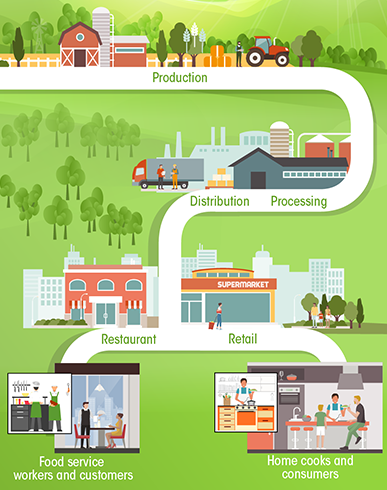Why Local Supply Chains should be Balanced with Longer Ones
The UK’s food system is grappling supply chains challenges post-COVID with fuel and post-Brexit labour shortages. Throw into the mix the carbon impacts, as well as healthy diets and much of the chatter is focusing on ‘local’.
So, what are the pros and cons, the caveats and advantages of keeping the supply chain local?
According to The National Food Strategy (Part 2), led by Henry Dimbleby, prior to WW2, UK sourced food produce was at an all time low with 70% of our food coming from beyond these islands. Currently more than half our food is home grown, which still means a great reliance on complex global food webs for the rest.
Locally Sourced May Not Be Sustainable
It should be noted that local does not necessarily mean sustainably sourced, or even small holding produced. “Implicit in the term local is that food is also sourced from outside large-scale supply chains such as those designed for supermarkets, producers are paid a fair price, and labour is both well rewarded and rewarding,” states Footprint in this recent article.
Choosing a local supplier could mean intensively farmed, high carbon impact and poor animal welfare. I know I like my beef (an occasional treat) to come from cows who have had a contented outdoor life. But even so, not all grass-fed beef is the same. Take for example, the carbon emissions of grass-fed UK beef steak (1.36kg CO2e for an 8oz) versus South American alternative (7.91kg CO2e).
Another example is homegrown tomatoes. When these need artificially heated, energy guzzling conditions, they are less preferable (at 2.5kg CO2e per kilogram) to trucked and shipped tomatoes (never airfreighted) from Southern Europe (0.24kg CO2e per kg). It’s clear that the choices can be complex.
Having the right information, and indeed knowing the right questions to ask suppliers is crucial. If you are unclear on what CO2e means, join the Carbon Literacy course outlined below to gain a fuller understanding.
Why Carbon Literacy Sustainable Food?
This is where Carbon Literacy for the Food Sector training comes into its own. Taking a short accredited course increases understanding of the carbon impacts of food choices. You will also learn how these integrate with other food system implications. It’s a vital step in developing awareness of the transformational actions needed to create future fit, resilient businesses.
Breaking down traditional procurement processes to move to purchasing from multiple, one-stop wholesalers to smaller, local farmers and producers undoubtedly creates challenges.
Building Trust in Local Supply Chains
The larger the caterer or retailer, the greater the challenges. Systems will need adapting, from both a processing stance and behaviourally. Purchasing staff must be ‘on board’ to reap the benefits versus perceived extra work. Relying on smaller providers to consistently fulfil contracted delivery requires trust and that can only come through working closely with those suppliers. A collaborative outlook allows that confidence to build over time.
Additionally, consumers need to accept that a sustainable food system means seasonal variations. Firm favourites may only be available at certain times of the year. Thus a combined communication and nudge approach is essential to gain buy in from end users.
The Benefits of Shorter Supply Chains
However, making a shift to include local (meaning small scale, sustainably sourced produce) farmers and producers, alongside traditional long supply chains provides a plethora of benefits. The Soil Association cites the main advantages as;
1. Boosting the local economy
Giving small food businesses more access to local markets boosts the regional economy. With fewer stages in the supply chain, local producers can also enjoy higher profit margins.
2. Coordinating logistics to lower carbon emissions
Many local councils have declared a climate emergency. Supporting development of local food production and distribution could lower transport emissions and increase efficiency.
3.Strengthening food security
COVID-19 showed some of the drawbacks of long supply chains. Creating shorter, regional supply chains, alongside longer supply chains, bolsters food security. That means we’re better prepared for times of uncertainty.
Transitioning to a sustainable food system which relies less on imports, but still gets the balance right to ensure resilience against inevitable future shocks is unquestionably difficult. But where does that leave you in the future if you don’t address these issues?
Despite the barriers it can be done. One success story of a larger organisation transitioning to support local, smaller companies lies around the example of Leicestershire procurement. Leicestershire Trading Services Catering arm holds the Soil Association Food for Life Gold Catering Mark. Working closely with farmers and processors in the area, contract tenders have been broken down.
Local buying partnerships can be developed for parts of the inventory, rather than just inviting bids from one-stop wholesalers tendering for everything. The result are positive, with a boost to the local economy. In addition, children in schools and hospital patients are fed nutritious meals from higher quality ingredients. .
Helping solve Supply Chain and Emissions Challenges
What can you do to beat supply chain challenges and ensure provision of climate friendly, low carbon food in your organisation?
Become Carbon Literate with an accredited Carbon Literacy Sustainable Food certification. The course is suitable for anyone who works in the post-farm food sector, ie food processing or catering/hospitality.
Book your place on Carbon Literacy Sustainable Food open course or to ask about in-House courses, scroll down and to the the short form here.
Find out about other sustainability courses or your full sustainability programme here.


Recent Comments